I still consider myself a fairly new stitcher, mainly because of the new things I am still learning. From reaching the comments, I realized there are a few things that I’ve learned that change my stitching.
Magnifiers:
Most of us need some kind of magnifiers for linen. I wouldn’t even start to try to stitch on 40 count without my good magnifying lamp. I keep a couple of 32 count projects going because I can see to stitch those with OTC cheaters/reading glasses. Find what works best for you. Some can get by with just using cheaters. Some use them over their Rx glasses. Some use a gizmo that clamps onto your regular glasses. There headlamp type things that magnify and light up. There’s a whole range of magnifying lamps. I tried several before I found one I love. There are small clamp on magnifying lamps. There are pole type extending lamps with heavy bases. What’s perfect for me may not be perfect for you. Again, I could not stitch without my good magnifying lamp so if you’re trying it and can’t see the holes, you may simply need a better magnifier.
Count the Threads:
The holes are small. On 40 count, they are very small. If you count the threads, instead of the holes, I find that easier. Since I’m using linen and stitching over two threads, instead of looking for the second hole, I count past the second thread. If I need to skip over leaving 2 stitches not stitched, I’ll count over 4 threads (2 threads per stitch x 2 stitches).

The above photo is 40 count linen through my magnifier. Not too hard to see, right?
The pictures below are a bit blurry. I was holding the fabric in my left hand and the camera in my right hand and trying to take the picture through through the magnifier.

I come up through a hole, then count over two threads. I’ll often stick the tip of my needle in that hole, then I’ll go up two threads and make the stitch into the correct hole, skipping two threads.
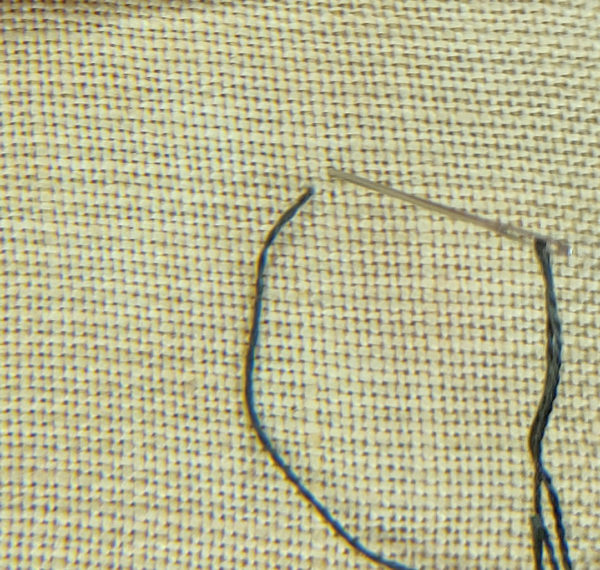
Once that leg of the stitch is completed, I’ll move over to the left two threads, and make the top left leg of the stitch, again leaving two threads unstitched.
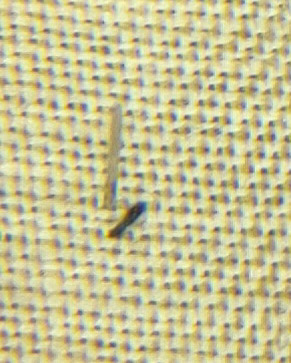
Can you see two threads easier than you can see the holes?
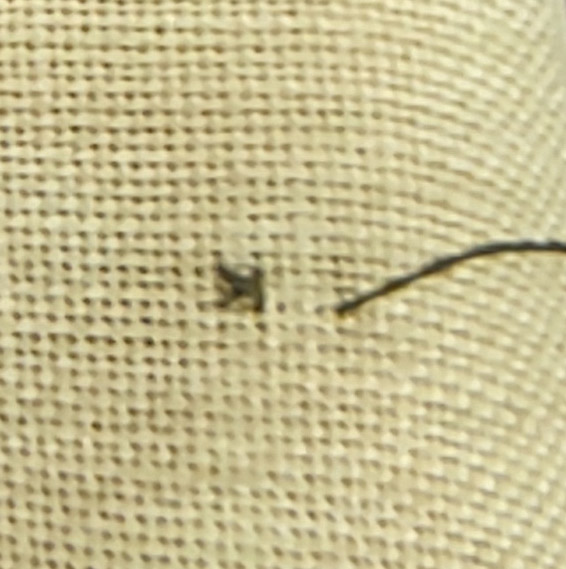
Then, when I’m ready to move over and leave spaces not stitched, I count the threads again and not the holes. To skip two stitches, I count 4 threads (2 threads x 2 stitches) and come up through the bottom left hole to make the first leg of the stitch.
Note: I go from bottom left to top right; then from top left to bottom right. Do it however you normally make your stitches.
Compare the Colors:
Here’s where a bit of a stash is helpful. When I’m choosing linen colors, I’ll pull out a fabric that I think is a good tan but if I pull out four fabrics that all look similar, then line them up, one may stand out as being too brown, too gray, too pink.
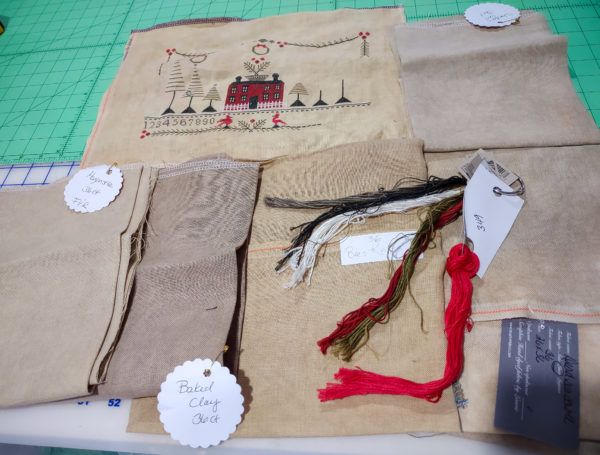
This is a photo I showed yesterday. See how the second from the left on the bottom row looks too brown? I gain perspective by looking at several similar shades together. But, the truth is that had I stitched this design on any of those linens, it would have been beautiful and I would have loved it. Once it’s done, I’ll likely never go back and and wish I had used something else.
Another thing – for designers, they can get most any fabric they want with a simple email or phone call. Most of us cannot. Taking my current project, Cranberry Christmas, as an example, the called for fabric is Winter Brew by R & R (bottom fabric).
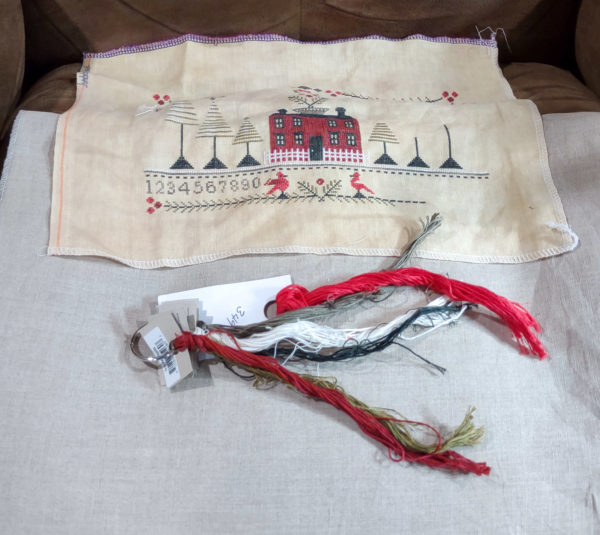
I used Sand Dune by Seraphim and I like my choice so much better. Don’t limit yourself to the called for fabric or the called for colors. In my mind, I’m thinking the designer might lay out three reds and then go back and forth on whether to use Red Rocks or Louisiana Hot Sauce. Is one right and one wrong? No! It’s just which one looked best to the designer. So, if I have a similar red and don’t have the called for, I’ll probably use what I have. If I like a different red better, I’ll probably use that.
On this particular chart, the house is charted to be stitched using both reds, in a vertical striped pattern. I looked at it and said (1) that looks like way more work and (2) I like it better solid. Don’t be afraid to change things if you think you’d like it better stitched a different way.
DMC Thread Color Card:
This book is invaluable to me. This is the new one and it’s currently out of stock but it is so worth the $24.99. It has the actual DMC threads, not just a printed color chart.
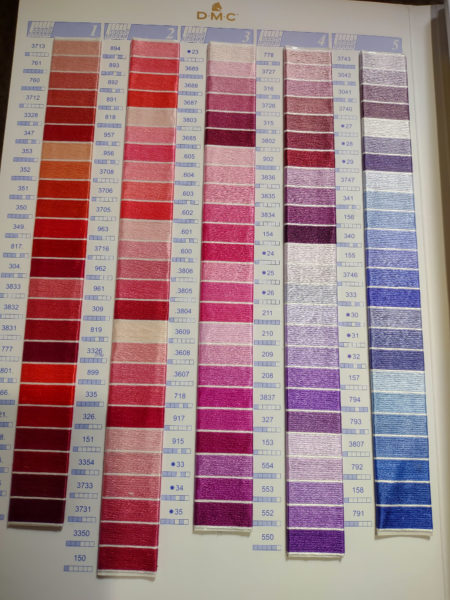
Most charts will have a DMC conversion even if the called for threads are overdyes or silk. If a chart calls for Classic Colorworks Used Brick and I don’t have it or it’s out of stock and I can’t get it, but lists DMC 3858 as an alternative, and if I want to stick with overdyes, I can use the DMC color card to see which overdyed floss I may have, whether it be Classic Colorworks, Weeks, Victoria Motto, etc., and come up with a color that will work.
Don’t sweat the small stuff. Remember, this is our hobby. This is how we relax, forget about what’s going on in the world and have fun. Do not allow your hobby to become stressful!

Ruth Chow says
Do you care what thread you come up at? I am sure there was a preference that I heard about where the thread acts differently depending on which intersection you come up in on linen, but I can never remember which one I’m supposed to use.
judy.blog@gmail.com says
I do not care. I’ve heard the same thing and, like you, can never remember. Jean Farish, who is my go to expert, says it absolutely does not matter.
Linda B says
Your explanation of counting the threads and not the holes is so valuable! Makes so much more sense to me now. One question I have is do you always make the complete cross stitch rather that a bunch of /// and then going back the other way to complete each stitch?
Christina says
Duh, the penny has dropped! I’ve been trying to count over 2 threads and up 2 threads without much luck and have nearly given up on linen, but the simple act of placing the needle in the hole after counting 2 threads across , then count 2 threads up , pinpoints the right hole YAY, thanks Judy
Nelle Coursey says
Thank you for all the help you have given me! You are a great source and a wonderful teacher. And I promise if you tell me to “watch the video” I will do it! LOL
judy.blog@gmail.com says
Glad to hear that you will watch the video without me having to come to your house and make you watch it!
Nelle Coursey says
Well, if that is what it takes to get you here, I just might not watch it and see if you will live up to that promise! LOL
judy.blog@gmail.com says
If it didn’t take forever to get there, I would come back and visit.
judyt52 says
I was so afraid to try stitching on anything other than Aida. I kept watching you and Jo do all your fabulous work and finally bought a small piece to try it, knowing it would end up in a total disaster. I am now totally hooked on linen. I like how after you get started you can “see” the next two holes almost automatically without counting each stitch. And if you have to count, you can glance back and see the “line” you are on. Do I goof up some? For sure, but not any more than I would on Aida. I have to get back to the shop and pick up more fabric.
judy.blog@gmail.com says
Thank you for sharing that. It is so intimidating! I’m not sure I would have switched to linen if I had been using Aida but since I hadn’t stitched in at least 30 years, it was almost like I was going to have to learn anew anyway. Sometimes my needle seems to just find the right hole without me counting and it seems almost like magic but once you get going, it really is like “just skip a hole”.
Nelle Coursey says
You know you are always welcome and if you should ever happen to come through here, please do call. I would love to see you again! I bet we would talk well into the night about everything! They still talk about the boobie pillow at our knitting sessions on Tuesday!!